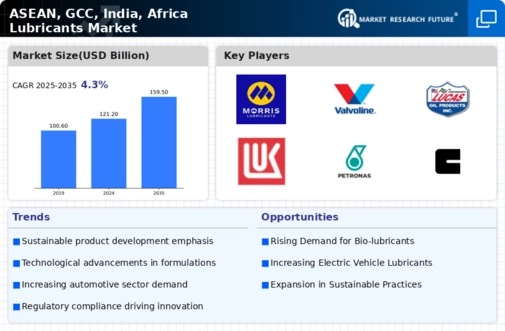Market Trends
Key Emerging Trends in the Global Lubricants Market
Industry Insights The ASEAN, G.C.C., Africa, and India lubricant market is on a steady rise and is anticipated to maintain its growth momentum throughout the forecast period. This growth is predominantly fueled by various industries such as chemicals, metals, energy, and manufacturing sectors, which continually rely on these lubricants for their operations.
These different industry segments collectively contributed to a substantial market worth of $22,940.1 million in 2017. Looking ahead, this market is projected to surge at a steady annual growth rate of 4.30%, poised to reach an estimated value of $29,532.9 million by the end of 2023. Notably, the energy and chemical manufacturing segments stand out as the primary drivers, expected to expand at impressive CAGR rates of 5.62% and 4.64%, respectively, every year.
Furthermore, within this landscape, bio-lubricants are emerging as the frontrunners in terms of growth potential. This segment is forecasted to exhibit the most rapid growth, clocking in at an impressive CAGR of 5.25% during the evaluation period from 2017 to 2023. The continuous surge in research and development efforts dedicated to enhancing bio-based lubricants, combined with the increasing usage of raw materials like soybean and palm oil, is set to open up numerous avenues for the growth of these bio-lubricants.
Expanding on this, bio-lubricants are gaining ground owing to their eco-friendly nature and the ongoing efforts to enhance their efficiency. Researchers are persistently exploring ways to improve these bio-based alternatives to traditional lubricants. This research not only aims to make these lubricants more effective but also to optimize the use of raw materials derived from soybean and palm oil, making them more accessible and cost-effective. These advancements create a favorable environment for the growth of bio-lubricants and offer promising prospects for this segment in the lubricant market.
Moreover, the increasing awareness and emphasis on sustainability have been instrumental in driving the shift towards bio-lubricants. Industries are becoming more conscious of their environmental impact and are actively seeking greener alternatives. This growing inclination towards environmentally friendly solutions has significantly contributed to the surging demand for bio-lubricants across various sectors.
In addition to the promising prospects of bio-lubricants, the robust growth of the energy and chemical manufacturing sectors plays a pivotal role in propelling the overall lubricant market forward. These industries, being the major consumers of lubricants, are driving the market dynamics due to their incessant need for these products in their day-to-day operations.
Furthermore, the escalating R&D endeavors focused on bio-lubricants highlight the industry's commitment to innovation. Researchers and manufacturers are continuously striving to improve the properties and performance of bio-based lubricants. This commitment to innovation not only ensures enhanced product efficiency but also expands the range of applications for bio-lubricants across diverse industries.
The escalating demand for bio-lubricants, attributed to their environmentally friendly nature and technological advancements, is poised to drive substantial growth in the lubricant market. This trend underscores a transformative shift towards sustainable solutions, reflecting a positive outlook for the market's future.
Overall, the lubricant market in the ASEAN, G.C.C., Africa, and India is witnessing steady growth, propelled by diverse industry segments and the burgeoning demand for bio-lubricants. This growth trajectory signifies a promising landscape characterized by evolving technological advancements and a rising focus on sustainability, shaping the future dynamics of the lubricant market.









Leave a Comment